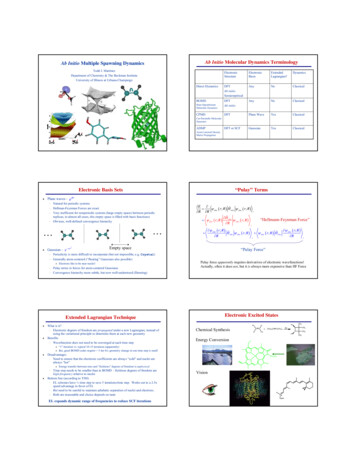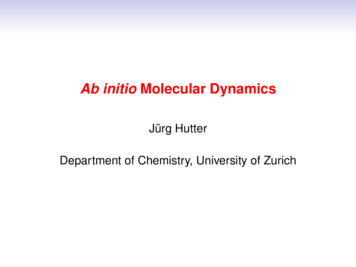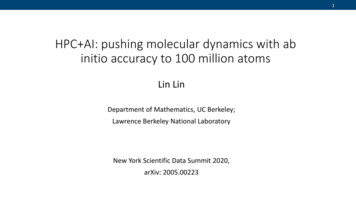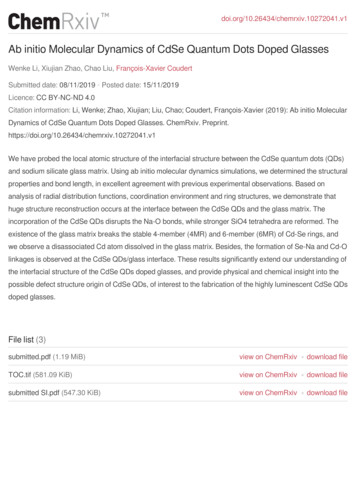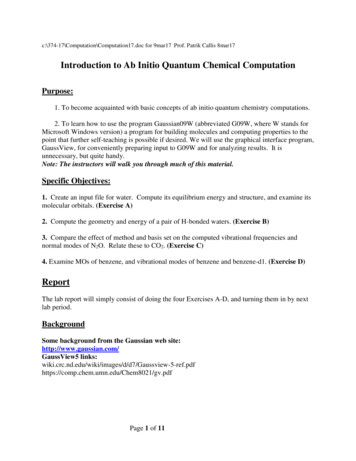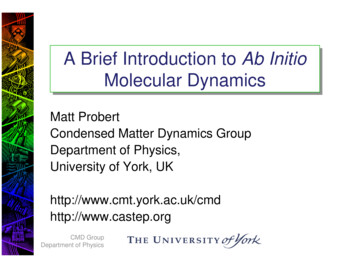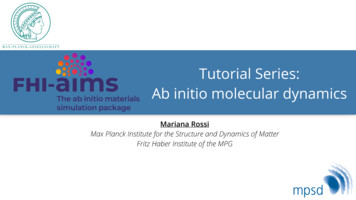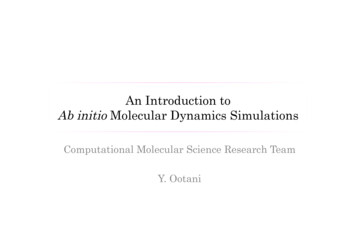
Transcription
An Introduction toAb initio Molecular Dynamics SimulationsComputational Molecular Science Research TeamY. Ootani
What is Theoretical Chemistry?Theoretical Chemistry・Explain chemical observation from physical theory・Predict the chemical propertythe universeAtom, Molecule1.0-10 mQuantummechanics12.4.91.00 m1.010 mClassical mechanics2
Classical mechanics and Quantum mechanicsClassical MechanicsNewton’s Equations of MotionF maQuantum MechanicsSchrödinger equationHΨ EΨ!"## %&#'( )) * Schrödinger equation for molecule n 1i2 i nmn m 1Za ZbZa a Ψ(x1 · · · xn X1 · · · Xm ) EΨ(x1 · · · xn X1 · · · Xm )2rRrijabiaai jim 1aa bNo analytical solution!!12.4.93
What is “Ab initio”MoleculeHΨ EΨBorn-OppenheimerapproximationNuclei Enuc ΨnucHnuc ΨnucFixElectronHele Ψele Eele ΨeleSolverelevant for chemical propertyChemical property・Spectrum・Electric energy・Electron density・Molecular structure・Magnetic property・Chemical bondetc.Ab initio calculationLatin term “from the beginning”12.4.94
Ab initio calculationAb initio quantum chemistry software・Gaussian ・Molpro・Dirac・Gamess・Molcasetc.・NWChem ・TurbomolNTChem・Scalable algorithm・Highly parallelized ab initio calculation12.4.95
Potential energy surfacePotential Energy Surface : PESExcited state励起状態 #',(-ポテンシャルエネルギー曲面HH .//"0.1)."#2.3,1)."#7.//"0.1)."#%'#',(-Ground state基底状態!"# %&'#()* 45.&.3,.56%/),50)5,'12.4.96
How do nucleus move?Potential energy surfaceProduct A?Reactant!"# %&'(*反応物Product B?生成物!"# %&'() ,-&'-.'MoleculeHΨ EΨNucleiBorn-OppenheimerapproximationElectron Enuc ΨnucHnuc ΨnucFixHele Ψele Eele ΨeleSolveSolve12.4.97
Classical approximation #',(-Classical mechanics #',(-Quantum mechanicsClassicalapproximation ./0 ./0!"# %&'#()*!"# %&'#()*Large computational costMoleculeHΨ EΨNucleiBorn-OppenheimerapproximationHnuc Ψnuc Enuc ΨnucSolve12.4.9ElectronHele Ψele Eele ΨeleClassicalF ma approximationSolve8
Ab initio Molecular DynamicsAb initio Molecular DynamicsElectronHele Ψele Eele Ψele(Ab initio calculation)ForceNucleiNuclearCoordinateF madissociation #',(-vibration .//"0.1)."#2.3,1)."#12.4.9!"# %&'#()*9
Beyond the Ab initio Molecular DynamicsTwo approximations・Born-Oppenheimer approximation・Classical approximationCan not reproduce・Nonadiabatic transition・Tunneling effect非断熱遷移%&''(!"'#!"# %')'* "*,*%"-.%/*'0"%")'Efficient schemes are required to reproduce these phenomena.・Surface Hopping Intuitive method・Ehrenfest12.4.9・Semi-classical method Mathematically complex No practical scheme10
Nonadiabatic transitionNonadiabatic transitionDNA basis!&-.(RhodopsinCytosine!"# %!"# %& ' (&)*( #,&(&"#)!!0%.)(/12.4.9&'()*") )%",-%.)(/"%"'(all-trans retinal11-cis retinal110,"/11
Photoisomerization of ene"# % &#'!!!!!J.Am.Chem.Soc. 125, 9542 (2003)!!trans!cis&'()"*&#'J.Am.Chem.Soc. 129, 6396 (2007)&'&()"(*(%" ,%-(&."%"'&!"# %%-(&.Surface Hopping!"# % ".J.Am.Chem.Soc. 128, 6284 (2006)12.4.912
Photoisomerization of azobenzenecis trans12.4.9・Isomerization occurs via rotation pathway.・Two pathways are found.13
Photoisomerization of azobenzenetrans cis・Trans-azobenzene has longer lifetime than cis-azobenzene.・Isomerization occurs via rotation pathway.12.4.914
Photoisomerization of azobenzene"# % &#'!!!!!!!!&'()"*&#'Blanching ratio&'&()"(*(%" ,%-(&."%"'&!"# %%-(&.!"# %OurresultsExp.cis trans0.450.4–0.56trans cis0.28 0.140.23–0.25 ".・Calculated blanching ratio are in good agreement with experimental results.12.4.915
Computational costElectronHele Ψele Eele Ψele(Ab initio ateForceNucleiF maExamplecis trans12.4.9trans cis・Ab initio calculation : 3 min・Ab initio calculation : 3 min・Simulation time : 240fs・Time step : 1.0 fs・Simulation time : 1000 〜 3000fs・Time step : 1.0 fs3min (240 1.0) 12h3min (1000〜3000 1.0) 50〜150h200 trajectories100 trajectories16
Nuclear Quantum EffectTunneling EffectUmbrella inversion of ammoniaProton transfer in 7-azaindole dimerIntramolecular hydrogen transferin malonaldehyde12.4.9!"## %&#'( )) * 17
Nuclear quantum effectComputational costs of quantum mechanical dynamics #',(-・Ab initio calculation : 3 min・Number of atoms : 9 21 degrees of freedom・Number of grids : 5・Time step : 0.2fs ./0・Simulation time : 500fs!"# %&'#()*3min 521 (500 0.2)7 1012 year!・Quantum mechanical dynamics・Semiclassical method Makri-Miller method Instanton theory Classical S-Matrix method12.4.9Have not been developed.18
SummaryFuture work・Electron correlation・Relativistic effect・Solvent・Nuclear Quantum effectCan computer be a test tube ?12.4.919
Ab initio Molecular Dynamics Simulations Computational Molecular Science Research Team Y. Ootani. What is Theoretical Chemistry? 12.4.9 2 ・Explain chemical observation from physical theory ・Predict the chemical property Theoretical Chemistry 1.0-10 m 1.00 m 1.010 m Quantum mechanics Classical mechanics Atom, Molecule the universe. Classical mechanics and Quantum mechanics 12.4.9 3 Quantum .
